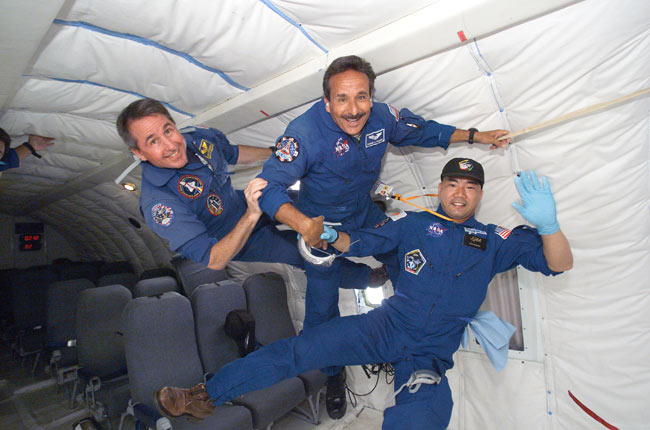Space Multitasking: A Look at Two STS-114 Mission Specialists

CAPE CANAVERAL, FL - Two NASA astronauts arepreparing for a multitasking mission aboard the space shuttle Discovery whenthe orbiter rockets into space later this year.
Veteranastronaut Wendy Lawrence and first-time flyer Charles Camarda have a busy flightahead of them when they launch aboard Discovery, NASA's first space shuttle tolaunch since the Columbia accident.
"Quitehonestly, the hardest thing about flying in space is that you can't fly thereroutinely," Lawrence told reporters in a preflight interview. "If you're tryingto design a new aircraft, you can fly a whole bunch of test flights, butunfortunately for us, we have to rely on computer models for spacecraft...and ittakes awhile to do the correct engineering analysis."
In fact,NASA has delayedDiscovery's flight, STS-114, from a May 22 target to no earlier than July 13 toallow additional time for launch debris verification analysis and external tankadjustments. The shuttle is set to be NASA's first return to flight launchsince Columbia broke apart while reentering the Earth's atmosphere on Feb. 1,2003, killing its seven-astronaut crew.
TheLoadmaster
A captainin the U.S. Navy as well as an accomplished helicopter pilot, Lawrence, 45, isno stranger to space shuttle flights.
The Jacksonville , Florida native was selected as an astronaut in 1992 and has flown aboard allthree of NASA's remaining space shuttles. Two of those missions, STS-86 aboardAtlantis and - most recently - STS-91 aboard Discovery, flew to the Russianspace station Mir. She also trained for a four-month stint aboard Mir, and hasamassed a total of 894 hours in space.
Breaking space news, the latest updates on rocket launches, skywatching events and more!
ForSTS-114, Lawrence will serve as Mission Specialist 4, operating of the space stationrobotic arm to maneuvera cargo module laden with supplies from Discovery's payload bay to an ISS port.She credits her helicopter experience, which totals about 1,500 hours of flightin six types of rotorcraft, with preparing her for the robotic arm work ahead.
"Whenyou're flying, you always have to think in three dimensions, and flying therobotic arm is the same thing," Lawrence said. "You have to get used to bothyour arms making control inputs."
Lawrence also serves as STS-114's loadmaster,in charge of negotiating the meticulous transfer of about 2,600 pounds (1,170kilograms) from the Raffaellocargo module into the ISS, then filling the empty pod up with trash and otherunnecessary equipment. Included in her duties is overseeing fellow shuttle andISS crewmembers in the cargo transfer, as well as making sure Discoveryastronauts have much-needed items in the event the orbiter suffers criticaldamage and its crew must take refugeaboard the space station.
"It's likepacking for a long trip, we have a lot of hygiene stuff," Lawrence said, addingthat she took care to make sure that additional waste collection units wereincluded in Discovery's cargo manifest. "What scares me the most about stayingon station is, well, think about living in a house with nine people and onlyone bathroom."
That'sDr. Astronaut to you
Making hisfirst spaceflight with the STS-114 mission, Camarda is one of three STS-114astronauts with an engineering doctorate - Stephen Robinson and Andrew Thomasare the others - and a veteran working inside NASA.
Hailingfrom Queens, New York, Camarda, 52, joined the space agency's ranks in 1974 asa research scientist at Langley Research Center in Hampton, Virginia. Afterserving in the Thermal Structures Branch of the Structures and MaterialsDivision, Camarda was tapped to head the department in 1994 and, two yearslater, reported to Johnson Space Center as an astronaut candidate. He hasserved as a backup crewmember for Expedition 8 to the ISS.
With anexpertise in thermal systems for the STS-114 mission, Camarda will serve asMission Specialist 5 during the spaceflight.
During theupcoming shuttle flight, Camarda will not only support cargo transfer betweenthe Raffaello module and the ISS, but will also help operate Discovery's new orbitalboom, a sensor-tipped extension to the shuttle's robotic arm designed toscan sensitive thermal protection areas for damage.
"This isreally drawing on my own background," Camarda said of the mission during apreflight interview, adding that STS-114's goals of demonstrating repairmethods for thermal protective tiles and reinforced carbon carbon (RCC) panelsare breaking new ground. "[Before now] we never thought we'd be able to repairthe orbiter in space."
During oneof the three spacewalksscheduled for the STS-114 flight, Camarda's fellow mission specialists Robinsonand Soichi Noguchi will try to demonstrate two methods to repairtile and carbon panels. Camarda has said he doesn't believe NASA's currentrepair methods are mature enough to ride home on if they are needed during STS-114. However, the additional preparation time due to the launch delay could help move the efforts forward.
"We have other[thermal protection system] repair concepts," Camarda said during a pressbriefing at Discovery's Pad 39B launch site Tuesday, adding that with theproper prioritizing and funding, progress could be made. "I think we would beable to mature some of these concepts."
But regardlessof whether tile and RCC methods mature in the next two months is Discovery'sSTS-114 mission, like its successor STS-121, is still a test flight at heart.
"Our job isto collect as much information as possible," said Camarda, a father of four."And I hope to come back and help use that information to ensure that we have asafe vehicle for the future."
- Fixing NASA: Complete Coverage of Space Shuttle Return to Flight

Tariq is the award-winning Editor-in-Chief of Space.com and joined the team in 2001. He covers human spaceflight, as well as skywatching and entertainment. He became Space.com's Editor-in-Chief in 2019. Before joining Space.com, Tariq was a staff reporter for The Los Angeles Times covering education and city beats in La Habra, Fullerton and Huntington Beach. He's a recipient of the 2022 Harry Kolcum Award for excellence in space reporting and the 2025 Space Pioneer Award from the National Space Society. He is an Eagle Scout and Space Camp alum with journalism degrees from the USC and NYU. You can find Tariq at Space.com and as the co-host to the This Week In Space podcast on the TWiT network. To see his latest project, you can follow Tariq on Twitter @tariqjmalik.
